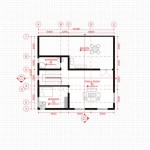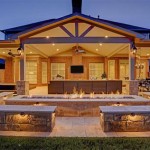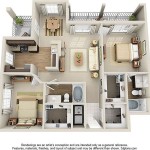How to Change Floor Plan Size in Revit Family 2024
Revit, a Building Information Modeling (BIM) software, is widely used for architectural design, structural engineering, MEP (Mechanical, Electrical, Plumbing) engineering, and construction. Families in Revit are the core building blocks used to create models. These families are reusable objects that can be customized to suit specific project needs. Floor plan size within a Revit family is a fundamental parameter that dictates the overall dimensions and spatial characteristics of the object. Modifying this aspect requires a clear understanding of family creation principles and parameter management within Revit.
This article will provide a detailed guide on how to change floor plan size within a Revit family in Revit 2024. It will cover the essential steps involved, from understanding reference planes and parameters to modifying existing geometry and ensuring the family behaves as intended when loaded into a project.
The process might seem intricate initially, but mastering the ability to modify floor plan size will provide control over the objects used in a project, enabling the creation of accurate and detailed building models.
Understanding Reference Planes and Parameters
Before diving into the actual modification process, it is crucial to understand the foundational elements that govern the size and shape of a Revit family: reference planes and parameters. These are interdependent and critical for creating flexible and adaptable families.
Reference Planes: Reference planes are invisible lines that define the framework of a Revit family. They act as guidelines for placement and alignment of geometry. Think of them as the skeletal structure upon which the visible parts of the family are built. In a 2D context, like a floor plan, reference planes typically represent the width, depth, and sometimes the center of the object. When creating or modifying a family, establishing strong reference planes is the first step. They provide a stable base for controlling the size because geometry is "locked" to them using constraints.
The importance of naming reference planes distinctly cannot be overstated. Proper naming conventions, such as "Width_Left," "Width_Right," "Depth_Front," and "Depth_Back," significantly improve the clarity and maintainability of the family, especially when dealing with complex geometries and numerous parameters. Name reference planes descriptively to easily identify their function when setting up parameters and constraints.
Parameters: Parameters are values that control the properties of a Revit family. They can be used to define the dimensions, materials, visibility, and other characteristics of the family. In the context of floor plan size, parameters are typically used to define the distance between reference planes, which in turn dictates the overall width and depth of the object. Parameters are classified into two main types: Type parameters and Instance parameters.
Type Parameters are specific to a particular type within the family. Changing a type parameter will affect all instances of that specific type in the project. For example, if creating a family for a standard door and changing its width by modifying a type parameter, all doors of that ‘type’ will update to the new width. Type parameters are useful when the size or properties are consistent across similar objects.
Instance Parameters are specific to each individual instance of the family in the project. This means you can change the parameters for one instance without affecting others of the same type. An example would be independently adjusting the width of a desk on a floor plan; instance parameters allow for flexibility and customization in specific locations within the project.
To change a parameter, select the object and review its properties. If the parameter is locked (indicated by a padlock icon), it must be unlocked before modifications can be made. Unlocking a parameter allows modification of its value, enabling the adjustment of the dimension it controls.
By linking geometry to reference planes and controlling those planes with parameters, a flexible and parametric family is created. Understanding the interplay between these two elements is vital for successful modifications to the floor plan size.
Modifying the Existing Geometry
Once the reference planes and parameters are fully understood, the next step is to adjust the existing geometry to reflect the desired floor plan size. This process involves aligning and locking the geometry to the reference planes, ensuring that when the parameters are changed, the geometry updates accordingly.
Aligning and Locking: The 'Align' tool (AL) is the primary tool for linking geometry to reference planes. To use it, first select the reference plane, then select the edge or surface of the geometry supposed to align with it. After alignment, a padlock icon will appear. Clicking this padlock locks the geometry to the reference plane. This lock ensures that the geometry will move with the reference plane as the parameter controlling the plane's position is changed.
It's good practice to test the alignment by temporarily changing the parameter controlling the distance between the reference planes. This verifies that the geometry moves as expected when the parameter is adjusted. If the geometry does not move correctly, the alignment and locking process needs to be reviewed and corrected.
Extrusions and Sweeps: Many families are built using Extrusions and Sweeps. When modifying the size of such elements, pay close attention to the sketch lines that define their profiles. These sketch lines must also be aligned and locked to the reference planes. Double click the extrusion or sweep to enter sketch mode, then use the 'Align' tool to align and lock each relevant sketch line to the appropriate reference plane.
Voids: If the family contains voids (used to create openings or subtract material), these voids must also be aligned and locked to the reference planes. The process is identical to that for solid geometry. Failing to properly constrain voids will result in unpredictable behavior when the family size is modified.
Arrayed Elements: Some families use arrays to replicate elements. If modifying the overall size impacts the spacing or number of arrayed elements, the array parameters may need to be adjusted. Ensure that the array spacing and the total number of elements are driven by parameters that are linked to the overall size parameters. This ensures that the array adapts correctly as the size changes.
Complex Shapes: Families with complex shapes might require a more iterative approach. Break down the shape into simpler components and align and lock each component individually. Use temporary dimensions to verify the distances between various parts of the geometry and reference planes. This will help identify any areas where the constraints are not properly defined.
It's crucial to maintain a systematic approach when modifying geometry. Work methodically, aligning and locking each element to the reference planes and testing the behavior as changes are made. This will prevent errors and ensure the family remains robust and predictable.
Implementing Parameter Changes and Testing
After establishing the reference planes, parameters, and aligning and locking the geometry, the final step is to implement the parameter changes and thoroughly test the family's behavior. This involves directly modifying the parameter values and observing how the geometry responds, ensuring that it adjusts correctly and predictably.
Accessing Family Types: To change the parameters, navigate to the "Family Types" dialog box. This can be accessed from the "Properties" panel when no element is selected in the family editor, or from the "Create" tab in the "Properties" panel. The Family Types dialog box displays all the parameters defined in the family, along with their current values.
Modifying Parameter Values: Within the Family Types dialog box, locate the parameters that control the floor plan size (e.g., Width, Depth). Enter new values for these parameters. As the values are changed, Revit will attempt to update the family geometry in real-time. Observe the model view carefully to ensure that the geometry adjusts as expected.
Testing Different Scenarios: It's essential to test the family's behavior under a range of different parameter values. Try small changes, large changes, and even extreme values to identify any potential issues. For example, if the width is set to a very small value, does the geometry collapse or distort? If the depth is set to a very large value, does the family still maintain its proportions? These tests will reveal any weaknesses in the constraint system.
Family Type Creation: Instead of modifying the existing family type, it is often beneficial to create new family types with different size parameters. This allows for multiple variations of the family to be available within the project. To create a new family type, click the "New Type" button in the Family Types dialog box, enter a name for the new type, and then modify the parameters as desired.
Project Environment Testing: Once the family has been thoroughly tested in the family editor, it's important to load it into a test project and test its behavior in a real-world environment. This will reveal any issues that might not be apparent in the family editor, such as interactions with other elements or performance problems.
Parameter Constraints: If certain parameters should be limited to a specific range, consider adding constraints to the parameter definitions. For example, a "Minimum Width" parameter can be created and used in a formula to prevent the "Width" parameter from being set to a value below the minimum. These constraints help ensure that the family is used correctly and prevent unexpected errors.
Reporting Parameters: Reporting Parameters can extract dimensional information from the family. These parameters are read-only and track the actual dimensions after adjustments are made. They are useful for labeling dimensions in schedules or for providing feedback on the actual size of the family after it has been resized.
Resolving Errors: If errors occur during the parameter modification process, Revit will display error messages. Carefully read these messages to understand the cause of the problem. Common errors include over-constrained geometry, conflicting constraints, and invalid parameter values. Resolve these errors by adjusting the constraints or parameter values as needed.
By systematically implementing parameter changes and thoroughly testing the family's behavior, one can ensure that the family is robust, predictable, and meets the specific requirements of the project.

How To Scale Floor Plan Image In Revit

Revit Setting Up Floor And Furniture Plan For Printing 2024

How Can I Expand This Viewport That Opens Up In Revit 2024 Autodesk Community

How To Jazz Up Floor Plan Graphics In Revit Tutorial

Solved Plan View Visibility In Revit Family Autodesk Community

How To Scale Anything In Revit Mashyo

How To Create Reference Planes In Revit Mashyo

Solved How To Scale Grids For Diffes View Scales Autodesk Community

How To Draw A Floor Plan In Revit 2024

Scaling Floor Plan View On A Sheet Without Changing Scale In Actual Autodesk Community
Related Posts








